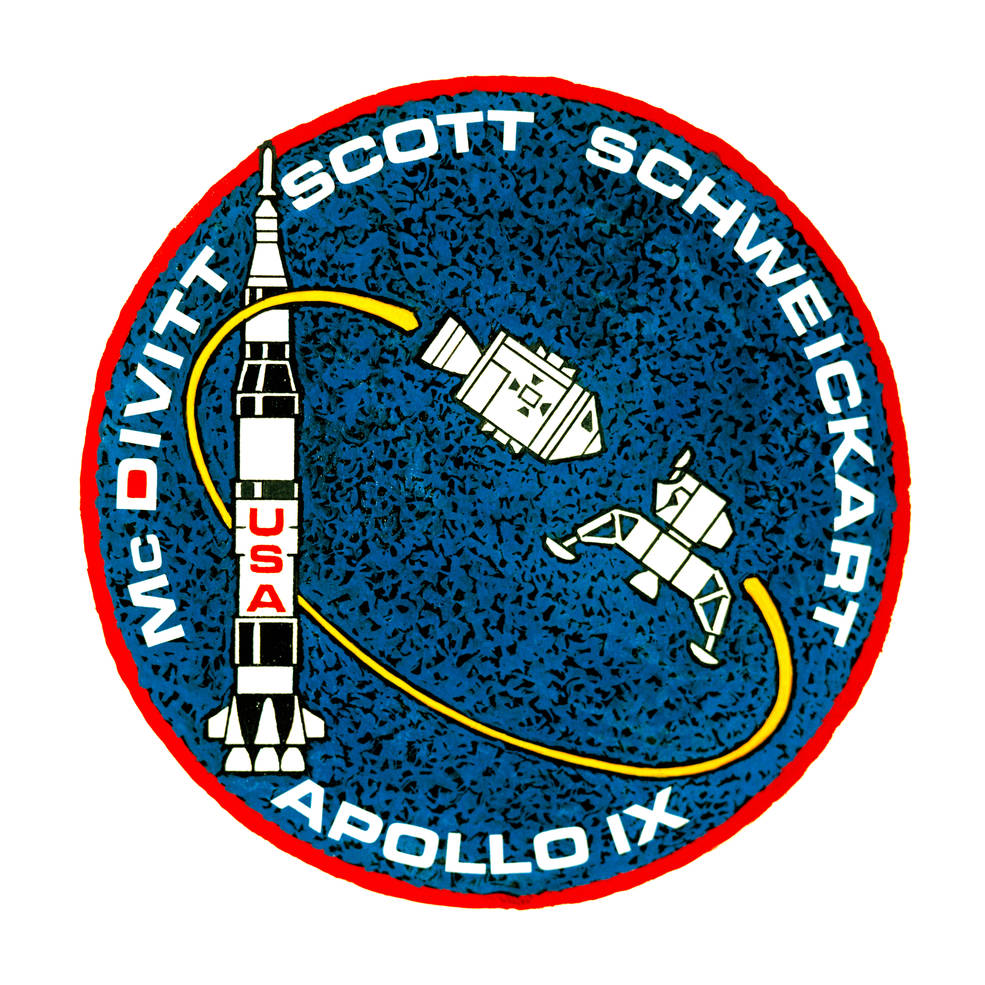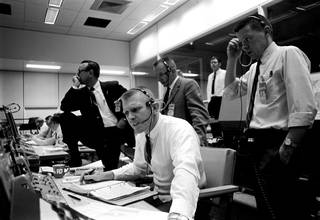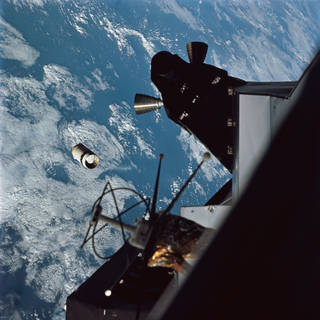At precisely 11:00 AM EST on Mar. 3, 1969, the five F-1 engines roared to life, and the 7.5 million pounds of thrust they generated slowly lifted the 363-foot tall Saturn V rocket off Launch Pad 39A at Kennedy Space Center (KSC). For only the second time, the giant rocket was lofting three astronauts into space, taking the next step to meet President John F. Kennedy’s goal of landing a man on the Moon and returning him safely to Earth before the end of the decade. Riding inside the Apollo 9 Command Module (CM) at the top of the rocket were Commander James A. McDivitt, Command Module Pilot David R. Scott, and Lunar Module Pilot Russell L. Schweickart. The goal of their 10-day Earth orbital mission was to test the Lunar Module (LM), the vehicle designed to land astronauts on the Moon’s surface. The three stages of the Saturn V placed the Apollo 9 spacecraft, still attached to the S-IVB third stage, into a precise orbit just over 11 minutes after liftoff. Weighing 95,231 pounds, Apollo 9 was the heaviest crewed spacecraft placed into Earth orbit to that time. To facilitate communications when the two spacecraft were flying independently, the crew designated their CM Gumdrop and the LM Spider, clear references to the general appearance of the two vehicles.
Left: Apollo 9 crew of (left to right) McDivitt, Scott, and Schweickart, pose in front of their Saturn V rocket at Launch Pad 39A.
Middle: Apollo 9 crew patch. Right: Launch of Apollo 9
Controllers in Firing Room 2 of KSC’s Launch Control Center (LCC) monitored the countdown and the launch. Joining them to view the liftoff was Vice President Spiro T. Agnew, accompanied by NASA Acting Administrator Thomas O. Paine and KSC Director Kurt H. Debus. Once the rocket had cleared the launch tower, oversight of the mission transferred from the LCC to Mission Control at the Manned Spacecraft Center, now the Johnson Space Center in Houston. There, three teams of controllers, led by Lead Flight Director Eugene F. Kranz and Flight Directors Gerald D. Griffin and M.P. “Pete” Frank, working in eight-hour shifts, monitored all aspects of the mission until splashdown. The capsule communicator, or Capcom, the astronaut in Mission Control who spoke directly with the crew, during the launch was Stuart A. Roosa. The other two Capcoms during the mission were Ronald E. Evans and Alfred M. Worden.
Left: Vice President Agnew (middle) being briefed by KSC Director Debus in the LCC prior to the
Apollo 9 launch. Right: Lead Flight Director Kranz (seated) and managers and controllers monitor the
Apollo 9 launch from Mission Control in Houston.
Less than two hours into the flight, during their second revolution around the Earth, the crew extended Gumdrop’s docking probe at the apex of the cone-shaped spacecraft in preparation for the next phase of the mission – transposition and docking. Two hours and 41 minutes after launch, the Command and Service Module separated from the S-IVB third stage and pulled a safe distance away. The four panels of the Spacecraft LM Adapter (SLA) that protected the LM during launch were jettisoned. McDivitt turned Gumdrop around to face Spider, still attached to the S-IVB, and slowly closed the gap between the two spacecraft, completing a successful docking. About an hour later, springs ejected the docked spacecraft from the S-IVB. Ground controllers over the next few hours twice restarted the S-IVB’s engine to simulate a Trans Lunar Injection, eventually sending the spent rocket stage into solar orbit.
Left: LM Spider still attached to the S-IVB stage, just prior to transposition and docking.
Right: The S-IVB stage after separation from the docked spacecraft, with LM thrusters and
antennas in the foreground.
Meanwhile, the crew busied itself with pressurizing the tunnel between Gumdrop and Spider, removed the CM hatch, connected umbilicals to power the LM while the two spacecraft remained docked, and replaced the hatch. The astronauts next performed the first of eight planned burns of the Service Propulsion System (SPS) engine, a five-second maneuver that raised the spacecraft’s orbit to allow better lighting for the rendezvous later in the mission. The burn also validated that the docking mechanism between the two vehicles as well as the LM itself were sturdy enough to handle to firing of the large SPS engine. After some housekeeping chores, the crew settled down for their first night’s sleep in space – for the first time in the Apollo Program, all crewmembers slept at the same time, unlike the previous missions during which at least one crewman was awake at all times to monitor spacecraft systems.
The next morning, after their breakfast, the crew busied itself with preparing for three SPS engine burns during the second day in space. The goal of these firings of varying durations was to demonstrate the controllability of the docked vehicles using the spacecraft’s digital autopilot. The maneuvers also changed the spacecraft’s orbit for better lighting conditions for the subsequent rendezvous and docking operations and reduced the overall weight of the Service Module to minimize fuel needed for later firings and the deorbit burn at the end of the mission. The second maneuver, lasting nearly two minutes, raised the orbit slightly. Three hours later, the SPS-3 burn lasted more than four and one half minutes and also raised the vehicle’s orbit. Another three hours later, the 28-second fourth maneuver adjusted the plane of the orbit. Mission Control considered all three burns successful. The crew began their second sleep period in space, in preparation for the following day’s activities that included entering the LM Spider for the first time.
Read McDivitt and Schweickart’s recollections of the Apollo 9 mission in their oral histories with the JSC History Office.
































